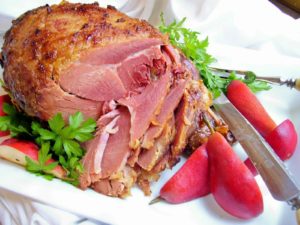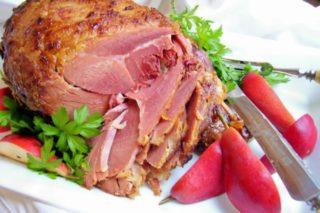November 30, 2020
Christmas Past. Christmas Present.
BY TOM YATES
No doubt, it’s been a heck of a year. After months of masking up, being apart, and staying socially distant, we’ve missed birthdays, anniversaries, funerals, weddings, holidays, and much much more. And now, it’s coming on Christmas. Different and distant.
In our new normal, Christmas won’t be like Christmases past. Even so, we can wear those past memories like warm tattered sweaters, live in the present, and look to the future.
As we navigate change during the holiday season, embrace joy and hope. Hold onto the good things. Hold fast to small indulgences. Go ahead, pull out the good china, polish some silver, glaze a fatty ham, roast a Christmas goose, or simply order take out. Whatever it takes, indulge just a little, and embrace Christmas present.
Around here, we’ll be scaling back and dialing things down. Simple is good. We have time.
Agood Christmas ham starts with a great ham. Browning’s Country Ham, from Dry Ridge, cures and ages their hams for 12 months. Both mild and robust, it’s one of the go-to hams around these parts.
Although I was forewarned to expect mold, it got the best of me. When I ripped open the butcher paper surrounding the ham, plumes of green-ashen powdered mold exploded from the package. Caught by the rays of the morning sun, the dust cloud dangled in the light for what seemed like an eternity. After a quick wipe down and clean up, I scrubbed the ham under warm water with a sturdy brush to remove the mold. Luckily, I had an enormous canning pot large enough to accommodate the ham. After plopping it into the pot, I filled it with enough water to cover the ham, maneuvered the lid over the protruding bone (most folks remove the hock), and scooted the ham into a corner of the kitchen to soak for two days, changing the water every 12 hours.
On the third day, I drained off the water and lifted the pot containing the plumped ham onto the stove top. After filling it with cold water, I topped it off with 6 bottles of Ale-8-One soda and a cup of pure maple syrup before cranking the heat to high. When the sweet gingery water came to a boil, I reduced it to a gentle simmer, covered the pot, and let it rip for 5 1/2 hours, about 25 minutes per pound.
When the internal temperature reached 160 degrees, I carefully removed the pot from the heat before wrapping the entire pot with several old quilts to let the ham slowly steep in its own juices overnight. Yep. Overnight. Pig in a blanket.

The next morning, I carefully removed the ham to a roasting pan and discarded the cooking liquid along a fence row in our backyard. Still hot from the quilted insulation, I removed the skin from the ham and trimmed some off some of the fat.
I lightly scored the soft fat cap on top of the ham, splashed the meat with bourbon, slathered the entire surface with good dijon mustard, and encrusted it with a thin layer of light brown sugar before sliding it into a preheated 400 degree oven.
When the brown sugar dissolved into the mustard and started to caramelize, I pulled the ham from the over to rest. At that stage, it could have been wrapped and chilled. Didn’t happen. After letting it rest for 30 minutes, I transferred the ham to a serving platter, scattered a few quartered Red Bartlett pears to the side, and finished with fresh lovage from my garden.
____
This article also appears on page 18 of the December 2020 print edition of ace magazine







